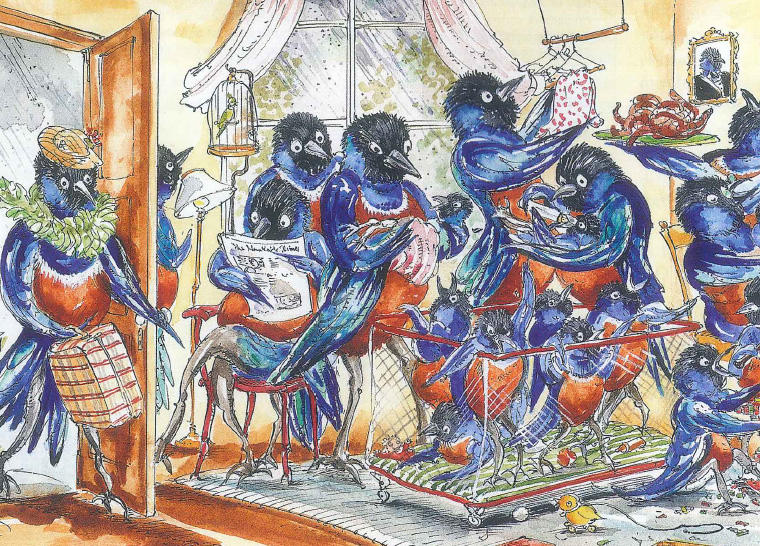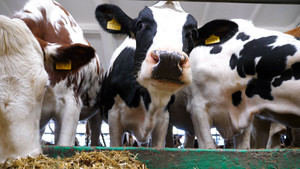“More Americans Living with Extended Family”
— CBS news headline from 2010“Their family groups, which include parents, stepparents, siblings, aunts, uncles, nieces, and nephews, can swell to upwards of 30 individuals, more than almost any other group-living avian species.”
— Dustin Rubenstein on the superb starling, Natural History magazine, 2009
On a February morning, in a winter when the sky really did seem to be falling — caving in all over with snow, sleet, and ice — Dustin Rubenstein, an assistant professor in Columbia’s Department of Ecology, Evolution, and Environmental Biology (E3B), sat in his office on the 10th floor of Schermerhorn Extension and thought about the rains in Africa.
Precipitation was in the air. January 2011 had been New York’s snowiest in history, and 2010, by NASA’s measurements, was the hottest global climate year on record. Now, outside Rubenstein’s window, the city was enameled in a white, bathtub-slick glaze, the city’s chunk of a 2000-mile-wide winter storm, one of the biggest in generations.
It was a fitting backdrop for a talk about Rubenstein’s work, where weather meets feather, beak meets beaker, and the past becomes a forecast.
“We’re trying to understand how variable environments with extreme weather events, like these storms, affect the behavior and physiology of birds,” says Rubenstein, a tall, fresh-faced behavioral and evolutionary ecologist who came to Columbia in 2009. “If we can understand how over the last tens of thousands of years organisms adapted to these variable environments, we might be able to understand how other organisms respond to climate change down the road.”
Ten years ago, as a PhD candidate at Cornell, Rubenstein went to Kenya to study the role of volatile environments in the development of family-living species. He focused — through a spotting scope, under a lone acacia tree, in the savanna heat — on Lamprotornis superbus, the superb starling, a small, showy East African bird with a blue breast, red-orange belly, and metallic blue-green wings. This creature was ideal: abundant, festively marked, and a practitioner of cooperative breeding, an arrangement shared by 10 percent of the world’s 10,000 existing bird species. In most cases, the family group consists of one egg-producing couple and a circle of relatives, or “helpers,” usually offspring from previous years who delay their own breeding to tend to the youngsters. The superb starling takes this lifestyle even further, according to Rubenstein: It’s a plural cooperative breeder, living in groups of 20 to 30, with three or four breeding pairs per group, each with its own nest and helpers. The key to this complex social system, Rubenstein theorizes, is the savanna itself — semi-arid grasslands dotted with clumps of trees, where rainfall is unpredictable.
“Species that live in more variable environments tend to go toward family groups more than those that don’t,” Rubenstein says. “We think that living with families is a way to cope with these environments. Having helpers in the dry years, when there isn’t much food around, means more individuals to bring food to the babies.”
During the past decade, Rubenstein and his students have captured and banded more than 800 birds. They monitor nine groups at any given time — about 200 to 250 birds, each with a metal leg band bearing a unique number and a color combination so that it can be recognized at a distance. “The superb starling breeds in two rainy-season peaks,” Rubenstein says. “We spend six or seven hours a day observing them. We identify the breeders and the helpers. We check the nests daily to see how many eggs are laid. In the dry season, we spend a lot of time catching birds in traps baited with papaya and cornmeal. We take hormone and blood samples, replace bands, and mark new birds that have immigrated in.”
The samples are taken back to the squeaky-clean laboratory in Schermerhorn Extension. Rubenstein characterizes the E3B facility as “a hybrid molecular physiology lab with the theme of social behavior and family living.” There, students extract, sequence, and analyze superb starling DNA and conduct other tests on immune function and communication. Lea Pollack, a junior majoring in environmental biology, is studying female dispersal patterns. (Rubenstein’s research shows that the males stay with the family, while the females often will leave to join other groups — and, on occasion, cheat on their mates — to ensure genetic diversity.) “Lea found in some of the old data that the females in the group were also closely related. Sisters might be dispersing together, or females that have already immigrated into groups might be recruiting female relatives. Lea has been extracting a lot of DNA from a couple of years’ worth of starling samples, and we’ll use the genetic details to look at relatedness patterns among females as they enter groups.”
Since the birds, male and female, are indistinguishable from each other visually, the lab looks at how the birds recognize their kin. Sara Keen, a bioacoustics specialist in the E3B master’s program, records the superb starlings’ high chirrups, which to an untrained ear sound like something between a rewinding cassette tape and the squeal of polished glass, and breaks down the aural fingerprints that appear on her computer screen in the form of a spectrogram. “These birds live with relatives, so they need to be able to recognize relatives,” Rubenstein says. “We think that’s done with group-specific calls.” Another grad student, Kathleen Apakupakul, is researching immune system function in the superb starling in relation to environmental variations and mate choice.
“We’re finding that everything is tied to that variation, from breeding behavior to stress physiology to immune function to how many sons or daughters the birds produce,” says Rubenstein. “The environment seems to be driving most of their lifestyle.”
In May, Rubenstein and 16 undergrads will go to Kenya for the end of the brief and fickle wet season. The moody climate of the sultry savanna might be a long way from the winter sludge outside Rubenstein’s window, but in some ways it’s just around the corner. “One consequence of global warming will be more variation and extreme weather,” Rubenstein says. “More winters with lots of snow, followed by summers with lots of drought.”
Two days after the Great Ice Storm of 2011, the U.S. Labor Department released its monthly employment figures. Construction jobs fell by 32,000. Severe weather was blamed. And with increasingly harsh conditions expected, and the financial climate already unstable, the trend in America among nonwinged bipeds toward multigenerational family living — a rise of 30 percent since 2000, according to census figures — seemed likely to continue.
“You never know when you’re going to need help,” Rubenstein says. “So rather than kick your kids out after they graduate, you might want to keep them around.”



